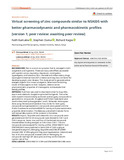| dc.description.abstract | BACKGROUND: Pain is a common symptom that is managed in both
outpatients and inpatients. There are many side effects associated
with opioids such as respiratory depression, constipation,
hyperalgesia, and tolerance. Non- steroidal anti-inflammatory drugs
cause gastrointestinal tract (GIT) irritation and may be a risk factor for
developing peptic ulcer disease. This study aimed to generate active
analgesic agents from known analgesics, determine the docking
scores of these agents to their receptors, determine the
pharmacokinetic properties of these agents, and evaluate their
toxicity profiles.
METHODS: PubChem was used to download smiles for ibuprofen,
aspirin and celecoxib. Avogadro optimized the ligands. The smiles
were copied to SwissSimilarity and were used as query compounds to
generate zinc compounds. DrugBank and Protein Data Bank were
used to download cyclooxygenase 1 and 2. Molecular docking was
done using Chimera and Autodock Vina. Smiles for both query
compounds and generated zinc compounds were pasted onto the
Protox II webserver and SwissADME for toxicity and pharmacokinetics
properties determination. The data was presented in tabular forms
with textual descriptions of the contents in the tables.
RESULTS: Aspirin, ibuprofen and celecoxib’s zinc compounds were
generated and the first 20 compounds were docked to COX-1 and
COX-2 enzymes. Seven, one, and four of the docked compounds
showed better binding energies to COX-2 than COX-1. The zinc
compounds were analyzed for toxicity profiles. ZINC01680731 and
ZINC33823423 were predicted to have LD50 of 1240 mg/kg as
compared to aspirin’s 250mg/kg. Ibuprofen and ZINC39120409
showed LD50 of 299mg/kg and they were hepatoactive. Celecoxib and
four of its zinc compounds showed LD50 of 1400mg/kg. All
compounds had high GIT absorption and they conformed with
Lipinski rule of five.
CONCLUSIONS: ZINC01680731 0.994 and ZINC00600558 0.988 were identified as the best compounds as they showed better binding
affinities, toxicities and pharmacokinetics properties compared to
standard compounds | en_US |

